Key Points
- The best fluffy cat breeds include favorites like the Persian, Ragdoll, and Maine Coon.
- Fluffy cats will groom themselves, but you should also brush them regularly.
- Some fluffy breeds, like the Siberian, are a good option for people with cat allergies.
Silky, luxurious coats, fluffy tails, and tufted ears — there’s no denying that fluffy cats are some of the cutest felines around. Whether they have short hair or long hair, it’s impossible to resist petting a cat with a beautiful coat. Even folks with severe allergies may be sorely tempted to offer up a head scratch.
Although fluffy cat breeds may have more grooming needs than other kitties (okay, a lot more), these breeds will also snuggle their way into your heart — and your lap, of course.
Plus, with a few tips, you can easily learn how to keep your fluffy cat’s coat clean and healthy. Unfortunately, you will be fighting a losing battle to keep cat hair off your clothes and furniture. And while you might expect long-hair cats to pose more of a problem for people with cat allergies, some of the fluffiest cats are also considered the most hypoallergenic cats.
Looking to welcome a “floofy” feline friend into your family? Read our guide to the best fluffy cat breeds. We’ll also give you some grooming tips to keep your cat’s coat fluffy and healthy.
1. Persian
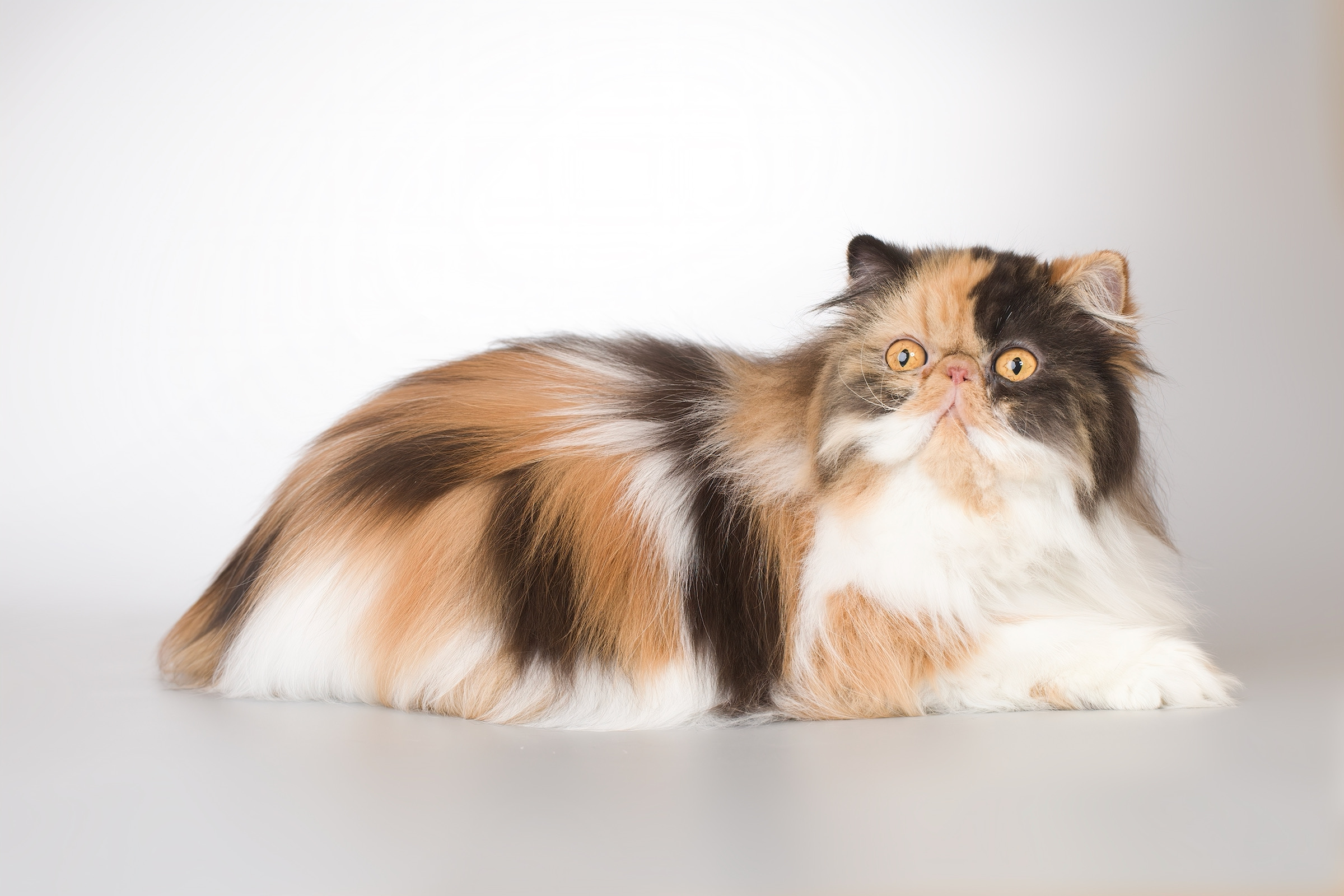
Persians are so popular that they’ve been among The Cat Fanciers’ Association’s (CFA) top 10 breeds for as long as such rankings have existed
Persian cats are known for their luxurious coats and adorable (and slightly grumpy) expressions. These long-haired beauties come in a number of colors and varieties, including a tabby variety and a Himalayan variety.
Persian owners report their cats as being sweet, gentle, and quiet cats. They also say that they’re excellent companions and love to snuggle up in your lap.
With their long, flowing coats, Persians should be brushed regularly to make sure their coats stay clean and tangle-free (as well as to avoid hairballs). Besides regular brushing, a Persian’s grooming routine should also include monthly baths to manage grease and dander.
2. Ragdoll
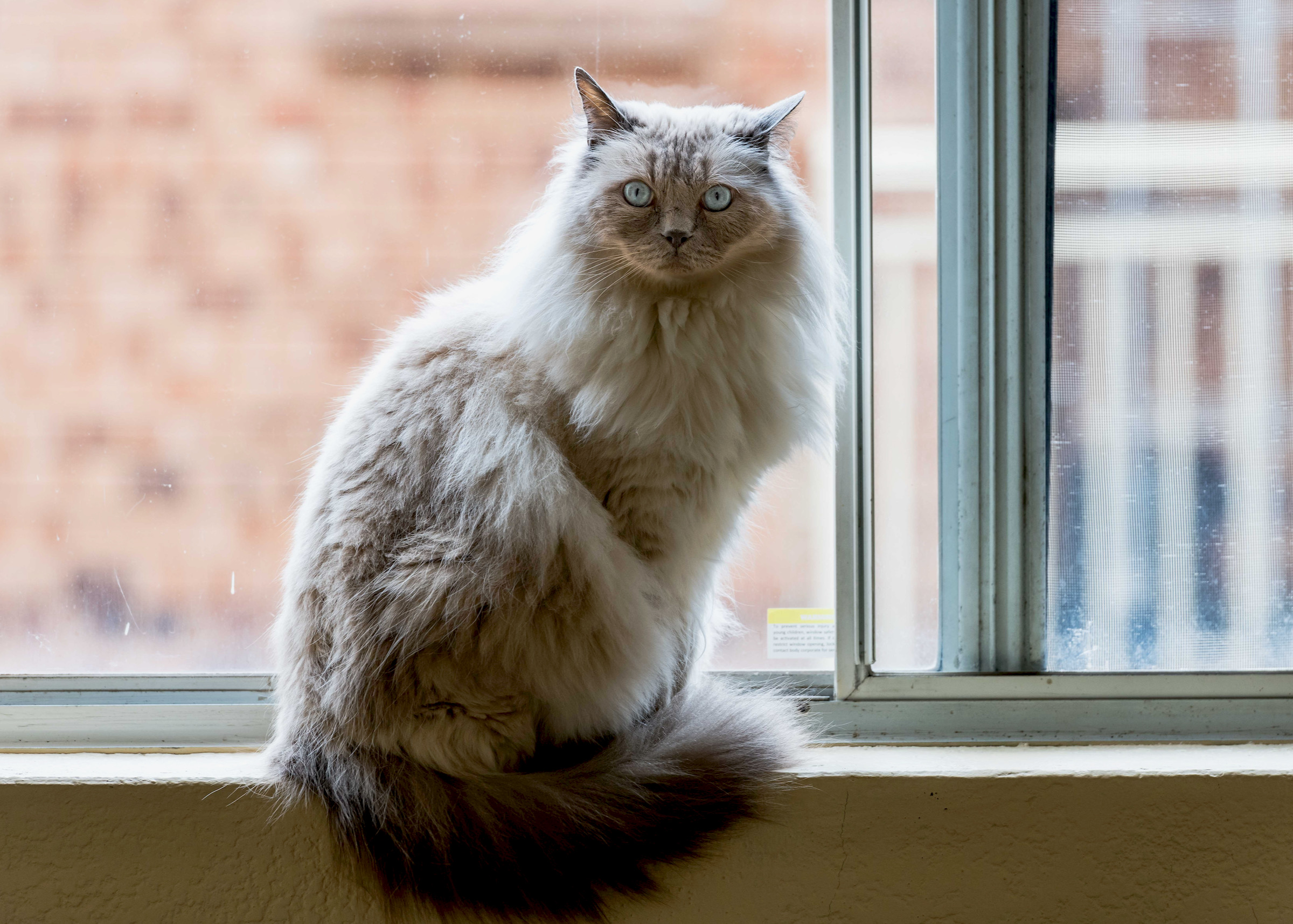
With a semi-long coat and striking blue eyes, you can’t help but fall in love with a Ragdoll. Ragdolls have plush, silky coats with pointed colors — meaning their bodies are lighter in color than their faces, tails, ears, and feet.
Ragdoll cats can get very attached to their family members and are known to follow you around the house. These felines are gentle, affectionate, and happy to share a home with other cats, dogs, and children. In fact, they got their name from their tendency to go limp like a ragdoll when picked up.
Ragdolls don’t have a thick undercoat, so they shed less and are not as prone to matting as other fluffy cat breeds. These cats generally have minimal grooming needs, but regular brushing can help them look their best.
3. Maine Coon
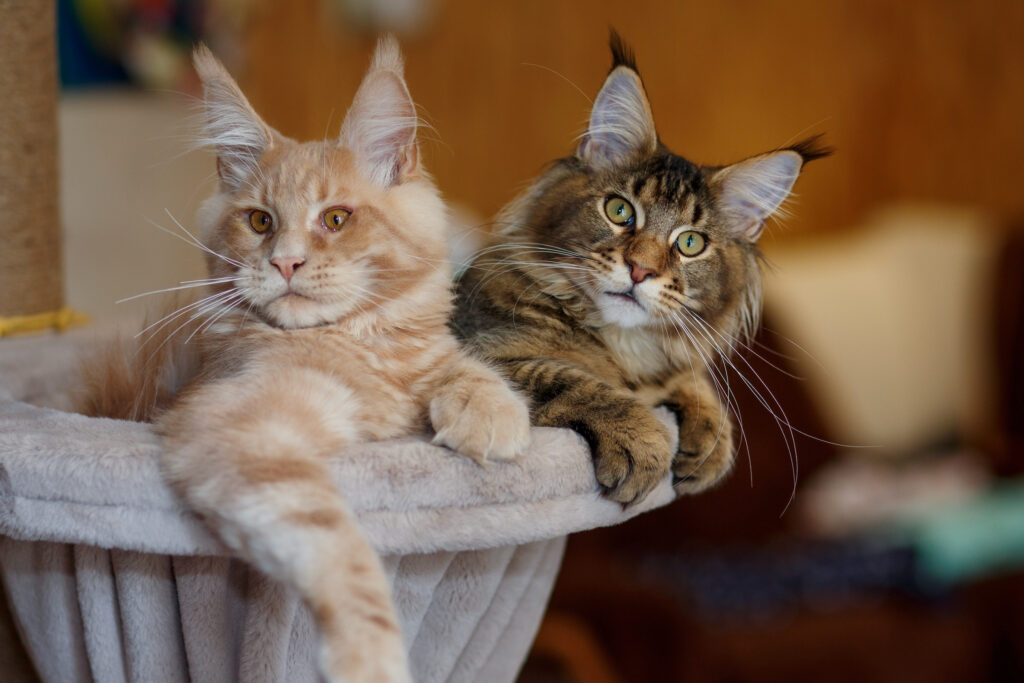
Maine Coons may be the epitome of a fluffy cat, with their long, silky coats, tuft ears and feet, and big bushy tails. These cats are also known for their large size — mature males can weigh 20 pounds or more.
Maine Coon cats are known for their intelligence, dog-like personalities, and friendly disposition. They get along well with kids and other pets and are often called the “gentle giants” of the cat world.
Maine Coons will want to be involved in everything that you’re doing, from sitting on your lap to peering over the edge of the bathtub. They might even splash around — unlike many other cats — many Maine Coons enjoy the water.
Despite their long hair, the Maine Coon’s coat isn’t particularly dense, and they mostly maintain their coats themselves. Regular brushing helps to remove your Maine Coon’s loose hair and dander, keeping their coat clean, healthy, and knot-free.
4. Norwegian Forest Cat
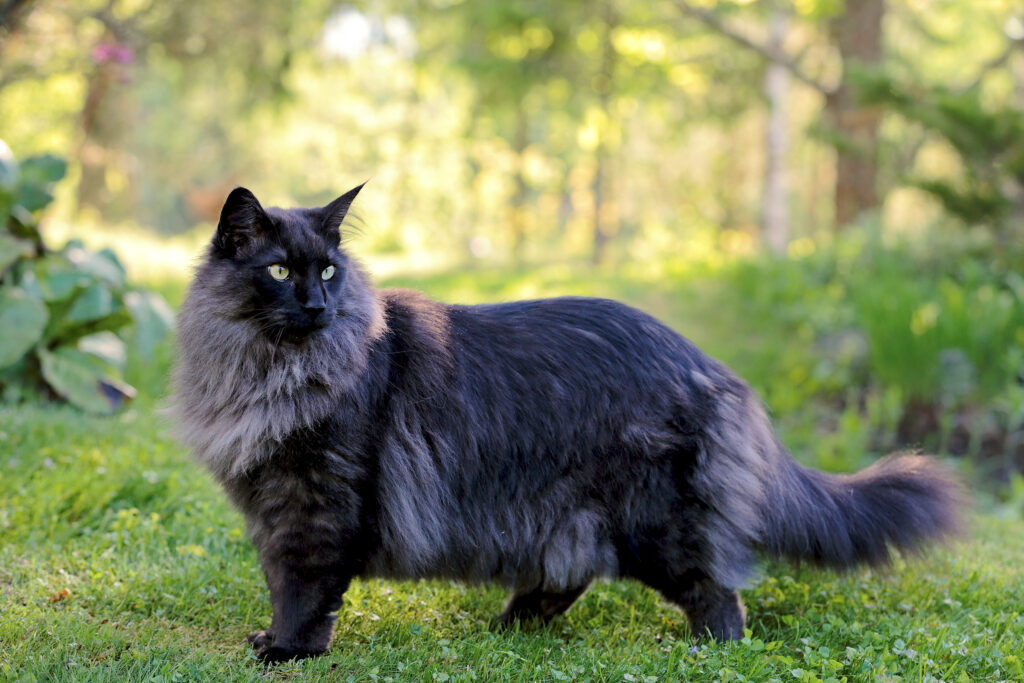
Another larger breed of cat, the Norwegian Forest Cat has a coat that was designed to withstand the cold winters of Norway. This cat has a dense double coat with a bushy tail and tuft paws.
Norwegian Forest Cats are both sensitive and social. They love the companionship of their family members, including other pets.
With both their large size and their long coats, these cats will definitely shed — especially seasonally. Norwegian Forest Cat owners should brush their cats once a week with a wire bristle brush or a metal comb. This helps keep their long fur detangled and reduces the amount of loose hair.
5. Siberian
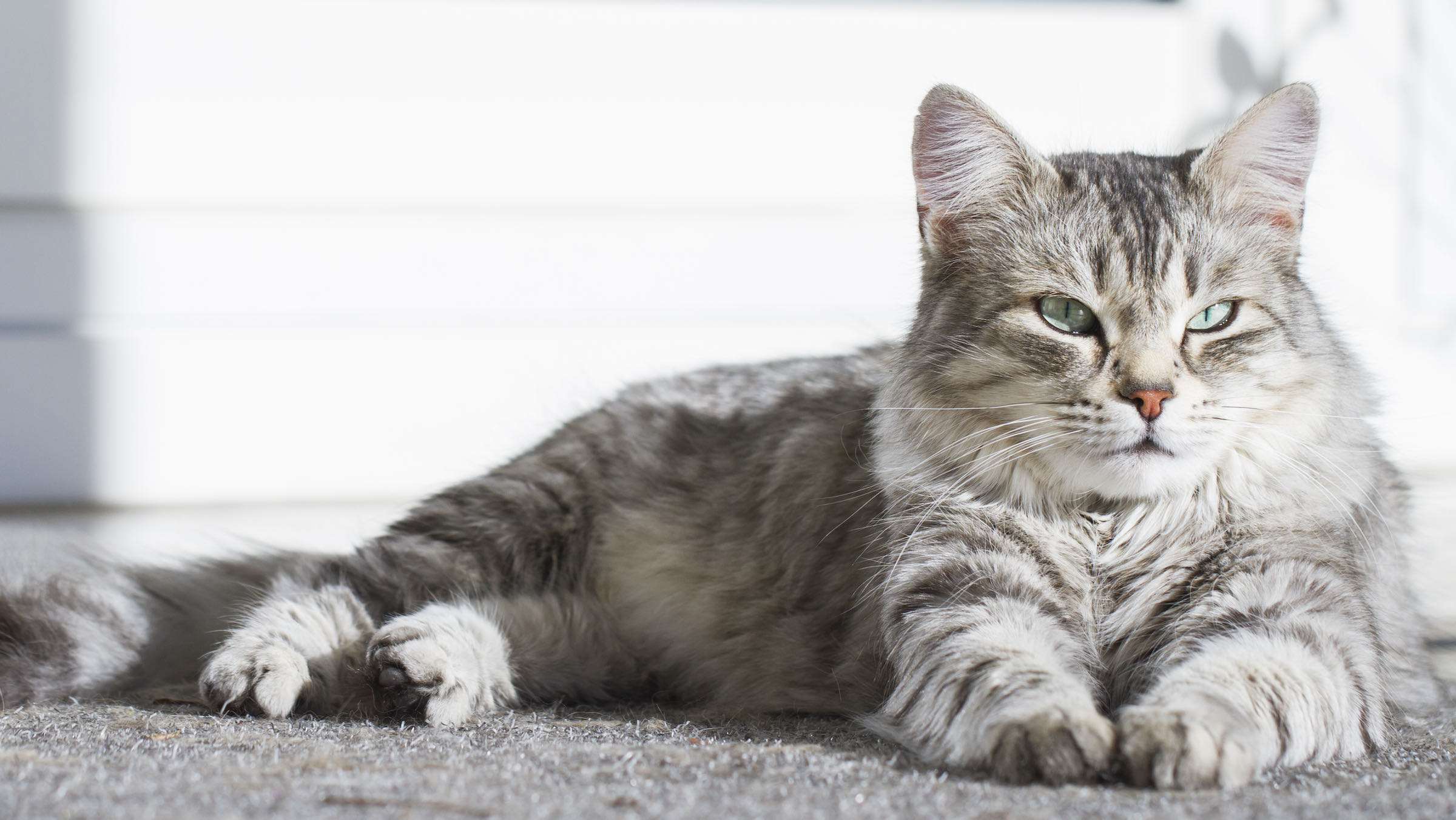
The Siberian cat is another medium-to-long-haired cat that was developed to withstand a cold climate. Siberian cats have dense, water-repellent triple coats, bushy tails, and full, fluffy backends.
Siberian owners say that their fluffy cats are quiet, easygoing, and playful. Siberians enjoy playing with toys, learning to fetch, or even jumping from place to place. Some Siberians have a charming, almost bird-like voice. They make excellent companions — Siberians prefer to spend time with their family, are very attentive, are gentle around children, and adapt easily to other pets. Like the Ragdoll breed, Siberians love to be held.
Pet Pro Tip: Regardless of which breed you bring home, make sure to get help protecting your new best fur friend with a best-in-class kitten insurance or cat insurance plan. Vet bills for unexpected accidents & illnesses can add up fast – it pays to be prepared with insurance.
Unlike many long-haired cats, Siberians are thought to be one of the most hypoallergenic fluffy cat breeds due to the lower level of Fel d 1 protein they produce.
When it comes to Siberian grooming, brush them regularly with a metal comb to manage shedding and prevent matting — about twice per week is the go-to. Also, avoid frequent bathing and reserve baths for when they are noticeably dirty or have gotten into something messy. For baths, make sure to use a cat-specific shampoo to protect their skin and coat.
Siberians generally enjoy water, which can make the overall grooming process more straightforward for everyone involved.
6. Birman
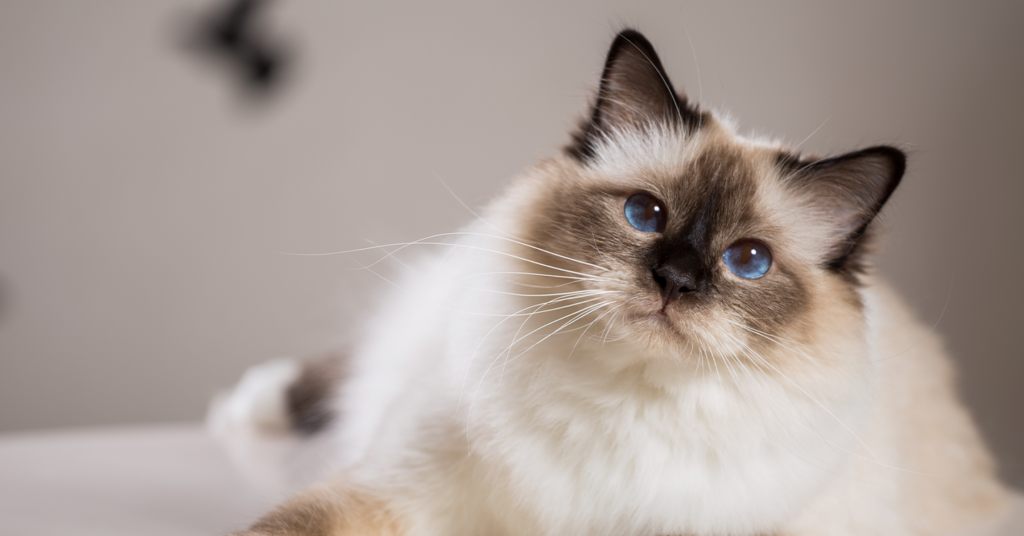
Birmans will win you over with their silky, soft, and lush coats and striking blue eyes. These cats are particularly fluffy around their necks and also have extra fluffy tails.
Birmans are known for their gentle, sweet, and affectionate personalities — they will be your best friend and accompany you in anything and everything you do. These cats love attention, they have quiet, chirp-like voices, and are happy to socialize with other cats, dogs, children, and people in general.
If you’re looking for a fluffy cat that’s low-maintenance in terms of personality and grooming, the Birman is a great choice. Not only are these cats agreeable companions, but they also have minimal grooming needs. Birman cats don’t have an undercoat, so they don’t experience matting, and therefore, occasional brushing is all they need.
To keep their coat fluffy and healthy, it’s recommended that you brush and comb your Birman once a week. In the spring, you may also want to give your cat a bath using a hand-held shower nozzle. Go gently over the skin and use a gentle cat shampoo to loosen dead fur during early molt.
7. British Shorthair
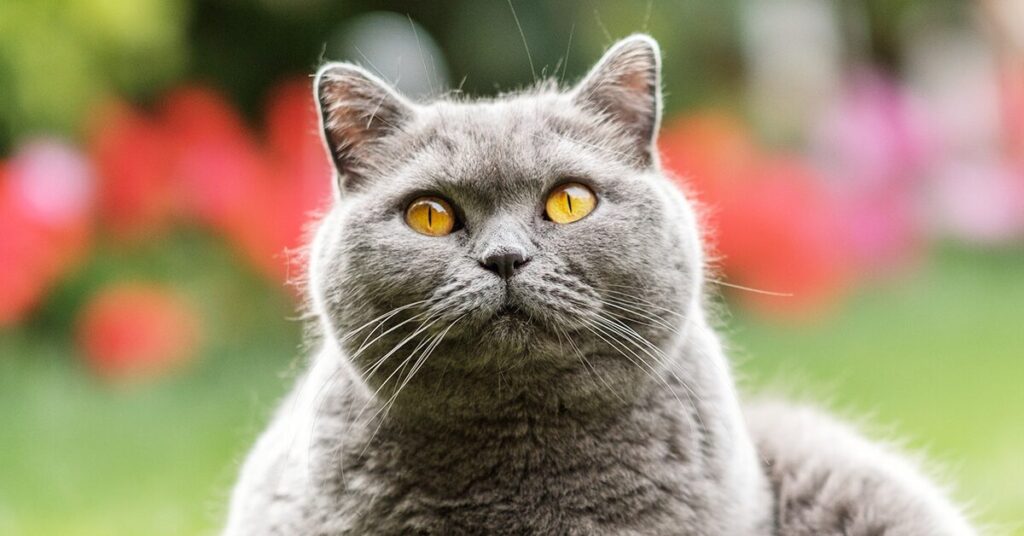
They may have short hair, but these cats are teddy-bear-like, with thick, plush coats that almost feel like velvet. British Shorthairs are well-known for their blue-colored coats, but they also come in over 30 other colors and patterns. With a round face, eyes, and ears, you can’t help but want to cuddle a British Shorthair.
These cats are easygoing and affectionate. Owners say that their British Shorthair cats can get along with all members of the household and love to show their silly side. These kitties can also be pretty quiet and sometimes reserved, but they enjoy family time, too.
With a plush, thick coat, the British Shorthair can benefit from regular grooming, especially during shedding season. Weekly brushing prevents mats and keeps their long coat healthy. Also, bathing should be done cautiously — once every four to six weeks — to avoid stripping their coat of essential oils. Use a mild, cat-specific shampoo and dilute it with water before applying.
8. Exotic Shorthair
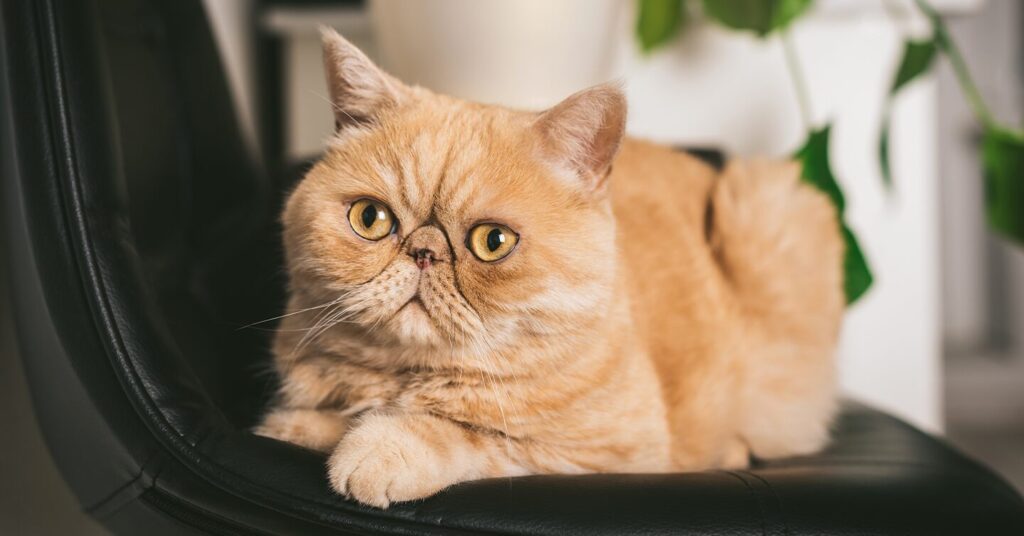
For a cat that’s quite similar to the Persian but requires much less grooming, you have the Exotic Shorthair. Although this cat may not be quite as fluffy as the Persian, the Exotic is still a cat with a lush, dense, and plush coat — similar to the British Shorthair.
Exotic Shorthairs are quiet, loyal, sweet, and extremely affectionate. These cats love attention, but are also playful and enjoy chasing a toy just as much as they like sleeping in your lap.
With the Exotic Shorthair, you don’t have to worry about tangles or mats, but regular brushing will help cut down on shedding — just once a week. Because of their minimal grooming needs compared to the Persian, cat lovers often call Exotics the “lazy man’s Persian.”
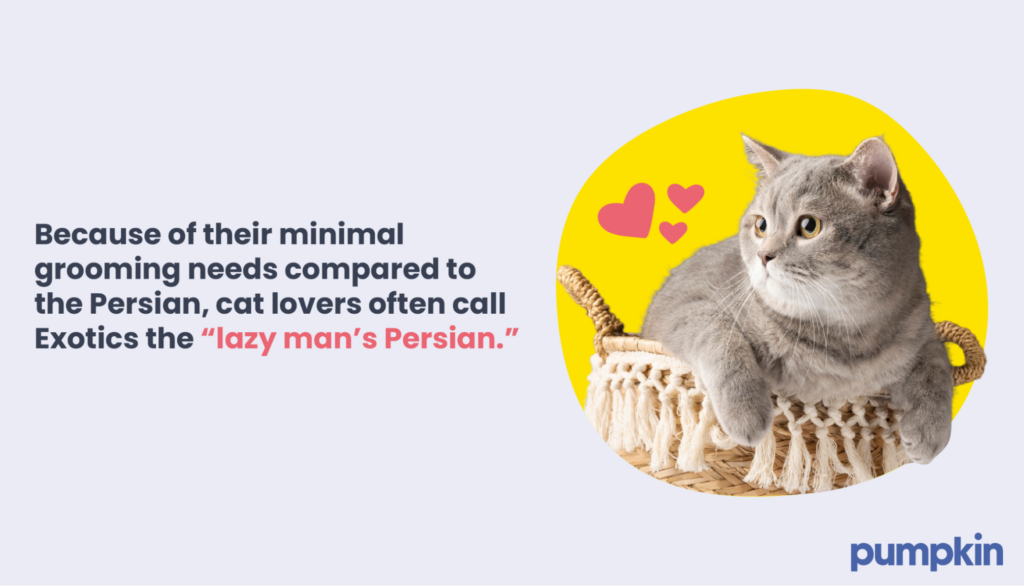
9. RagaMuffin
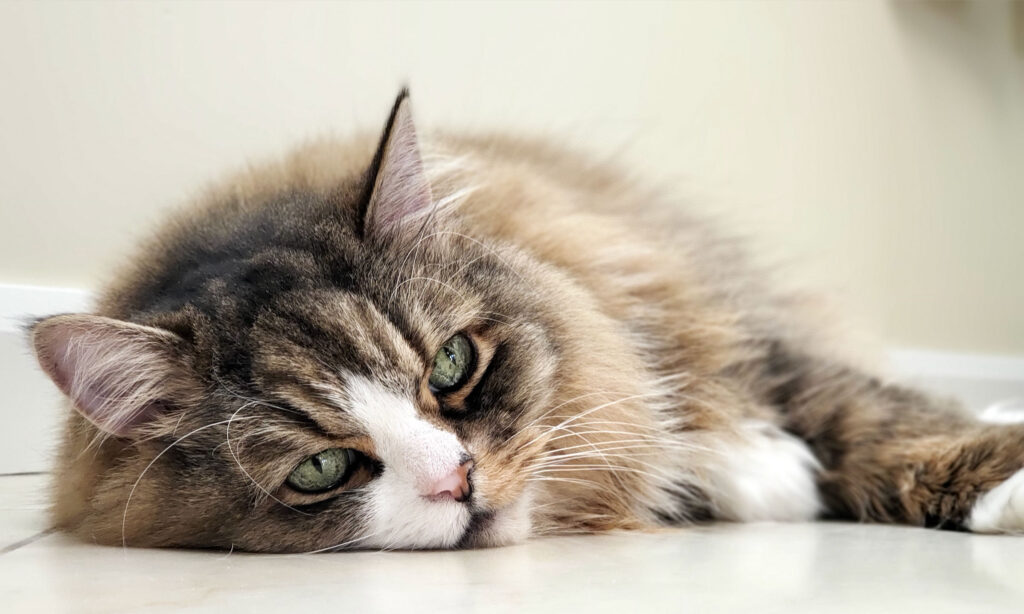
With a name like RagaMuffin, it’s no surprise that this cat is on our list of the fluffiest cat breeds.
The RagaMuffin has a luxurious coat that’s medium in length and thick and soft. These cats are also known for their wide variety of colors and patterns, including tabby and white, tortoiseshell, and mink.
RagaMuffins are incredibly sweet and bond closely to their families. These cats love children, other pets, and are happy to be your companion wherever you go. Although RagaMuffins are often content to cuddle in your lap or hang out in your arms, they’re also very playful as well.
In terms of grooming, RagaMuffins are relatively low-maintenance. Their coats don’t mat or clump easily, so they’re easy to keep clean and healthy. Regular brushing will help cut down on shedding and remove any dead hair. Stick to a once-weekly brushing schedule to maintain their coat’s condition and manage any shedding.
10. Somali
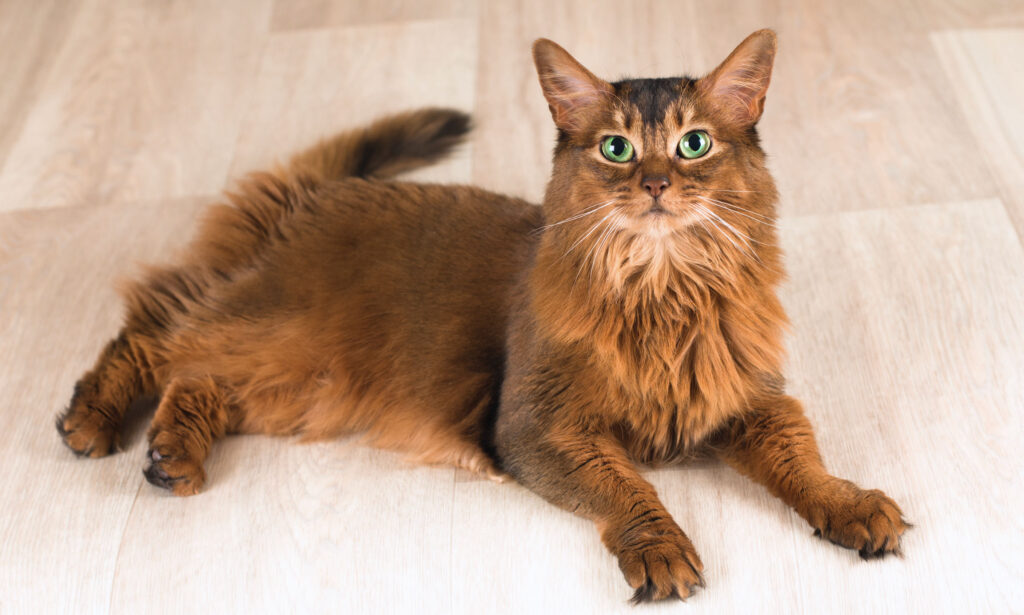
Somalis are instantly recognized by the color of their coats and their full, plumed tails. These cats have bushy tails, tuft toes, and a soft, silky coat. Somalis often come in a red color, giving them an almost fox-like appearance.
Somalis are known for their alert, smart, and playful personalities. These cats can even be a little mischievous — they’re said to open cupboards and play in water — but when playtime is over, they settle down to be your most loyal companion.
Unlike some of the other cat breeds on our list, Somalis don’t shed very much, so their grooming needs are minimal. Somali owners can keep their cat’s coats fluffy and soft by mixing a small amount of grooming in with daily play.
Grooming tips for fluffy cats
Although all cats groom themselves, certain breeds with thicker and longer hair will need a little extra care. That’s why if you’re thinking about bringing one of these fluffy cat breeds into your family, it’s important to take the time to read up on your breed’s grooming needs.
Even among the fluffiest cats, some breeds will require more grooming than others, and some will shed more than others. Here are some tips to set yourself up for success.
Brush regularly
For fluffy cats, there are many benefits of regular brushing:
- Eliminate loose hairs and dead skin cells, which keeps the coat clear of dirt, debris, and parasites.
- Spreads the cat’s natural skin oils across their fur.
- Reduces the amount of hair cats ingest during self-grooming, minimizing hairballs.
- Lessens the presence of hair and dander in your home, which is helpful for individuals with allergies.
While cat breeds differ slightly in their brushing needs, once or twice a week is generally the golden rule. But for breeds with thicker coats, such as Persians and Ragdolls, you may want to keep a closer eye and increase the frequency of brushing sessions if necessary.
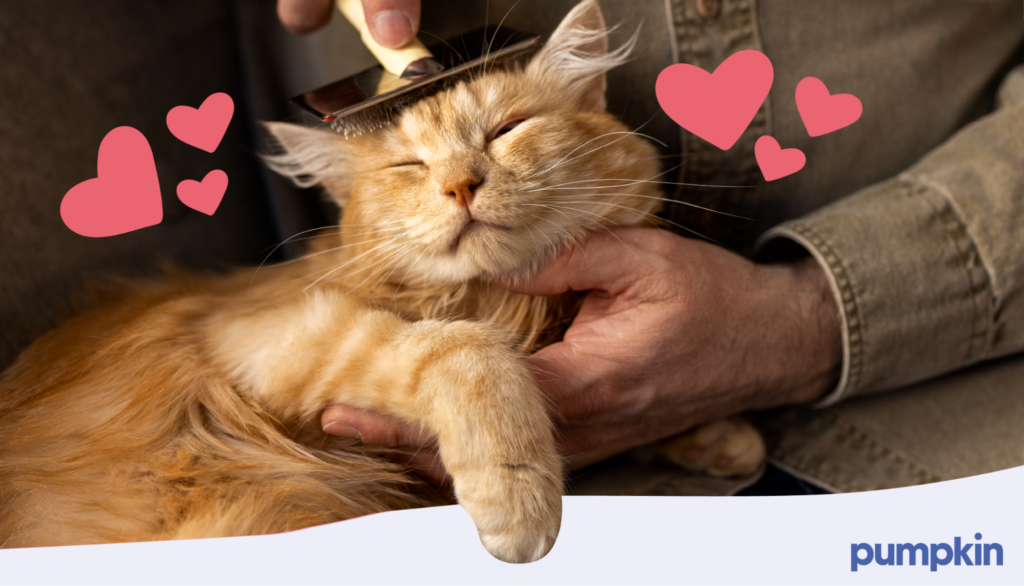
Use the right brush
There are numerous brush types available for grooming your cat. For long-haired cats, a long-toothed metal comb or brush is effective for removing loose hair and minor tangles. Stiff bristle brushes and those designed for heavy shedding seasons are also options, depending on your cat’s grooming needs (and wants).
To best care for your cat’s coat, it’s important to choose the right brush. You may even consider investing in multiple brushes to address different grooming needs, whether seasonal, sensitivity-related, or specific to certain areas of their coat.
Check for mats or tangles
Long-haired cats are more prone to matting or tangles, so it’s important to check regularly for these problem spots. Generally, regular brushing can help prevent these issues, but they can still pop up. If your cat has a mat or tangle, you’ll want to be extra careful when removing it so you don’t accidentally tear the skin underneath.
If you’re unable to detangle or remove a mat, consult a professional pet groomer or your veterinarian for assistance. Additionally, if you discover any skin abnormalities, irritations, or bumps while examining your kitty for mats and tangles, it’s best to consult your veterinarian.
Get started early
Although some cats love to be brushed, some will require more patience and work. Therefore, the best thing you can do is get started early. Teach your cat from kittenhood to tolerate brushing by giving them treats or other forms of positive reinforcement. Grooming your cat can be a form of bonding — and hopefully, you’ll both learn to love this time you get to spend together.
Visit a groomer
Fluffy cats may occasionally need a haircut, especially during the changing of the seasons. While you can and should have a grooming routine of your own, don’t be afraid to ask for professional help. Cat groomers will make sure your cat is as comfortable and clean as possible, no matter the season.
The joy of loving a fluffy cat
Having a fluffy cat to snuggle with is one of life’s great joys. With the right care, like regular brushing, bathing, and trims when needed, you can give your cat’s coat just the right amount of fluffiness.
Fluffy cat breeds: FAQs
- https://cfa.org/breed/persian/
- https://pangovet.com/pet-lifestyle/cats/how-much-does-a-ragdoll-cat-shed/
- https://cfa.org/breed/maine-coon-cat/
- https://www.catster.com/lifestyle/do-maine-coon-cats-like-water/
- https://www.ncbi.nlm.nih.gov/pmc/articles/PMC5753643/
- https://pangovet.com/pet-lifestyle/cats/birman-cat-facts/
- https://untamed.com/blogs/cat-breeds/british-shorthair-grooming
- https://www.dailypaws.com/cats-kittens/cat-breeds/munchkin




